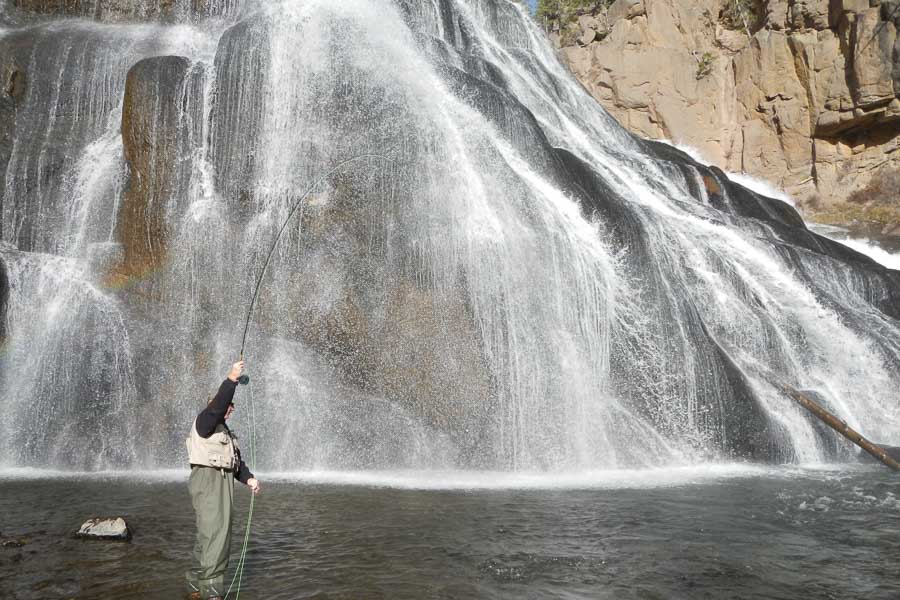Located in the southern portion of Yellowstone Park, the Lewis is part of the Snake River drainage that flows south towards Grand Teton National Park. Since most fishing in Yellowstone Park is focused on the Madison and Yellowstone drainages in the western and northern sections of the park, respectively, these southern fisheries are often overlooked. The Lewis rises in Shoshone Lake, which is the largest lake in the Lower 48 with no road access. After a several mile stretch known locally as “The Channel”, the Lewis finds its way into Lewis Lake, which is even larger and the 2nd largest lake in Yellowstone Park. Below Lewis Lake, the river traverses a flat meadow before plunging into a deep canyon. The river exits the canyon as it meets the Snake, just north of the Yellowstone Park boundary. While not a major fishing destination, the Lewis is within striking distance of Jackson Hole, Wyoming and can provide an interesting option when travelling between other rivers.
Fly-Fishing the Lewis River Overview
Lewis River has several different incarnations as a fishery. The channel between Lewis Lake and Shoshone Lake is best fished in the late fall, when large Brown and Lake Trout migrate into the channel to spawn. These fish run 16”-20” on average. The meadow stretch below Lewis Lake is populated by both Brown and Brook Trout. There are not many fish in this stretch, but the Browns reach good sizes, while the Brookies are small. Fishing is best here in July when the mayflies are hatching. Into the Lewis River Canyon, below Lewis Falls, Cutthroat make up most of the fish population. The Cutties here run on the small side, but they will eat dry flies throughout the summer. In the fall, some Brown Trout show up that have migrated out of Jackson Lake. Though they are large, they are also few and far between.
Fishing the Lewis River - Shoshone Lake to Lewis Lake
Fishing in “The Channel” is best reserved for late fall, just before the close of the Yellowstone Park fishing season. There are few resident fish here, so wait until the Browns and Lakers make their spawning run. It is a 3 mile hike to reach the mouth of the channel and Lewis Lake, and an additional 4 miles up the channel to Shoshones. This is best done as an overnight trip, which can be done by backpacking or canoe. This requires the appropriate permits, so be sure to consult with park authorities.
The lower half of “The Channel” is deep, slow, and has an abundance of deadfall and snags along the bank. This stretch is best fished with a streamer. I prefer baitfish patterns like a Clouser Minnow or Flash Fry. White and Yellow are my top colors, though others work as well. Both Browns and Lakers are aggressive carnivores, so don’t be afraid to fish big flies or utilize a quick retrieve. The middle to upper sections of the channel are swifter and shallower. Much of the river is broad and flat but there are some good holes to be found. Streamers work here as well, but nymphing becomes viable in the swifter water. Midges, small beadheads, and egg patterns all work well here.
The Channel is the main spawning ground for both lakes, so minimize your wading and take care not to step on any redds. Also, do not target fish that are on redds or actively paired up with other fish. The water is generally shallow and quite clear, so if you spot a fish you should be able to tell whether it is staging (fair game) or spawning (leave alone).
Fishing the Lewis River - Lewis Lake to Lewis Canyon- Meadow Stretch
The two miles of Lewis Meadows are broad, flat, and slow. Resembling a giant spring creek, the fishing is very technical for both Brown and Brook Trout. The only reasonable time to fish this water is when hatches of mayflies draw fish to the surface, making them easy to locate. Look for Green Drakes and Pale Morning Duns during July and Blue Winged Olives during the fall. You will want to carry precise patterns matching multiple stages of the hatch: emergers, duns, and cripples. A long, fine leader is necessary, as is the skill to land it softly on the water. Beginners need not apply on this stretch, this is major league fly fishing.
Fishing the Lewis River - Lewis River Canyon
Reaching the bottom of the canyon, which is over 1000 feet deep in places, is no easy task. If you do, expect to find smallish Cutthroats, with the occasional larger fish found in some of the deep holes. In the fall, there is always the chance of running into a large Brown or Lake Trout from Jackson Lake, but these fish are rare and should be seen as a bonus. If you are targeting the Cutts during the summer, choose and attractor dry like a PMX or Stimulator. Streamers are a good bet in the larger, deeper pools, as you might turn up a larger Cutthroat or migrant if it is fall.




